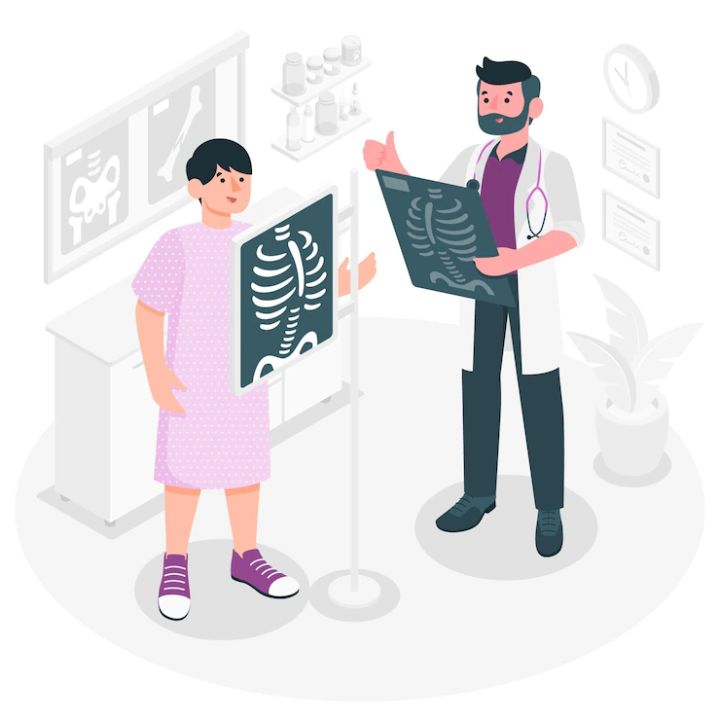Rib stress fractures are a type of injury that affects the ribs, which can be caused by repetitive movements or trauma to the chest area. Rib stress fractures can also occur due to underlying medical conditions such as osteoporosis, weakening bones and making them more prone to fractures.
It is important to distinguish between rib fractures and rib stress injuries, as they are two different conditions. A rib fracture is a complete break or crack in the rib bone, while a rib stress injury is a partial break in the bone caused by repetitive stress. On the other hand, a rib stress reaction is a precursor to a stress fracture caused by micro-damage to the bone due to repetitive activity.
It is crucial to understand the difference between these conditions, as the treatment approach may vary depending on the severity of the injury.
When a person presents with symptoms of rib stress fractures, the first step is to conduct a physical examination. The examination will focus on the affected area and may involve assessing the range of motion, level of pain, and any visible swelling or bruising.

Photo Credit: storyset
Further diagnostic testing will be required if the physical examination suggests a rib stress fracture. Medical imaging techniques such as X-rays, CT scans, and MRIs may be used to confirm the diagnosis and determine the extent of the injury.
During the physical examination, the physician may ask the patient to perform various movements to assess range of motion and pain levels. The affected area may be palpated (gently pressed) to check for any tenderness or swelling. The physician may also take a medical history to determine whether the patient has any underlying medical conditions that may be contributing factors.
X-rays, CT scans, and MRIs are commonly used to diagnose rib stress fractures. X-rays are typically the first imaging test ordered and can highlight any breaks in the bone. However, X-rays may not always show early-stage rib stress fractures or stress reactions, which can be detected with other imaging tests, such as CT scans and MRIs.
A CT scan can provide detailed images of the bones and rib cage. It can also help pinpoint the location and severity of the fracture, which can aid in the determination of the best course of treatment.
An MRI uses magnetic fields and radio waves to create detailed images of the inside of the body. MRIs are particularly useful in detecting rib stress reactions and early-stage fractures that may not be visible on an X-ray or CT scan.
If a rib stress fracture is suspected, seeking medical attention promptly to prevent further complications is essential. Delaying diagnosis and proper treatment can result in longer recovery times and increased risk of reinjury.
When treating rib stress fractures, the primary approach is conservative. In most cases, the goal is to manage pain and rest the affected area to promote healing.
Rest and avoiding activities that may worsen the injury are critical in allowing the bone to heal. Depending on the severity of the injury, a period of rest ranging from several days to weeks may be necessary.

Photo Credit: stefamerpik
Over-the-counter pain medications, such as acetaminophen and ibuprofen, can help manage pain and inflammation. Your doctor may also prescribe stronger pain medication if needed.
Once the pain and inflammation have subsided, rehabilitation exercises can help restore strength and flexibility to the affected area. These exercises may include stretching, massage, and other physical therapy techniques.
Surgery may sometimes be necessary to repair severe or complicated rib stress fractures. However, this is usually a last resort and conservative treatments are typically sufficient.
Overall, recovery time for rib stress fractures varies based on the severity of the injury and the individual. It is essential to follow your doctor’s instructions and avoid returning to physical activity until you have fully healed to prevent re-injury.
Rib stress fractures can occur due to a variety of reasons. The most common cause is repetitive movements, such as those in sports requiring continuous arm movements like cricket, tennis, or baseball. The constant stress on the rib cage can cause small cracks to form over time, leading to a stress fracture.
Another cause of rib stress fractures is trauma. Falling or being hit in the chest area can cause a sudden and forceful impact, leading to a fracture. This can also happen due to car accidents or other similar instances.

Photo Credit: storyset
Underlying medical conditions like osteoporosis and cancer can also increase the risk of rib fractures. These conditions weaken the bones, making them more susceptible to fractures.
In some cases, rib stress fractures can also occur due to sudden increases in activity levels without proper rest or preparation. This is commonly seen in athletes who push themselves beyond their limits without allowing sufficient time for their bodies to adapt.
Identifying the underlying cause of rib stress fractures is crucial to prevent them from recurring. Seeking medical attention and taking appropriate precautions can go a long way in preventing future occurrences of stress fractures.
Preventing rib stress fractures can be challenging, but there are several things you can do to reduce your risk of this injury.
Before engaging in any physical activity, it’s essential to warm up properly. This could include light cardio exercise, stretching, and mobility exercises. A proper warm-up helps increase blood flow to the muscles and prepares them for the activity to come. It can also reduce the risk of sustaining an injury, including rib stress fractures.
Good posture is crucial for preventing rib stress fractures, particularly in sports that involve repetitive movements. It helps maintain the correct alignment of the spine, which reduces strain on the ribs and other parts of the body. Make sure you maintain an upright posture during your daily activities to avoid slouching or bending forward too much.
When engaging in high-risk activities such as contact sports or extreme sports, wearing appropriate protective gear is crucial.

Photo Credit: wavebreakermedia-micro
For example, if you’re playing rugby, wearing a protective vest is essential. Similarly, if you’re cycling, wearing a helmet is essential. Protective gear can help absorb the impact of any blows or falls, reducing the risk of sustaining a rib stress fracture.
If you’re new to a physical activity or returning after a break, taking things slowly is essential. Gradually increasing the intensity and duration of your exercise routine can help your body adjust and avoid the risk of injury, including rib stress fractures. Avoid pushing yourself too hard too quickly, as this can put undue strain on your muscles and bones, leading to injury.
Eating a healthy, balanced diet is essential for maintaining strong bones and muscles, which can help prevent rib stress fractures. Be sure to eat a variety of foods rich in calcium and other essential nutrients, and limit your intake of processed foods, sugar and saturated fats.
A: Recovery time varies depending on the severity of the fracture, but it typically takes 6-12 weeks for the bone to heal. Rest and following a rehabilitation plan are crucial for a successful recovery.
A: It is not recommended to continue participating in sports with a rib stress fracture as it can cause further damage and delay healing. Resting and following the recommended treatment plan for a full recovery is crucial before returning to sports.
A: Complications of rib stress fractures include chronic pain, delayed healing, and the risk of the fracture not healing properly, leading to a need for surgery.
A: It is essential to seek medical attention if you experience any symptoms of a rib stress fracture, such as constant pain, difficulty breathing, or swelling. Early diagnosis and treatment can prevent further complications and shorten the recovery time.
A: Poor posture can contribute to rib stress fractures, as it puts additional stress on the ribs. Maintaining good posture and body mechanics during physical activities and daily life can prevent stress fractures from developing.
A: Yes, athletes are more susceptible to rib stress fractures due to the repetitive and high-impact nature of their activities. Athletes must take preventative measures and seek medical attention if they experience any symptoms.
A: To prevent rib stress fractures, it is essential to maintain proper posture and body mechanics, follow a gradual training program, and wear proper protective gear during physical activities. Adequate rest and nutrition are also crucial for preventing stress fractures.